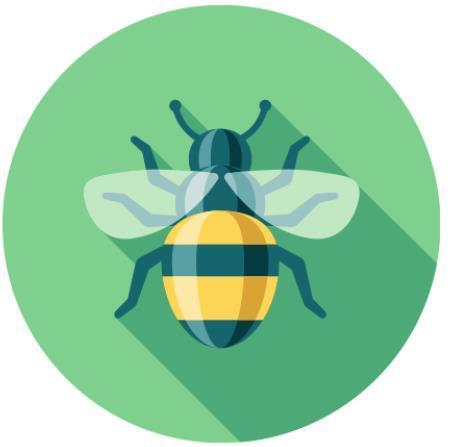

Answers to Go
SAN MARCOS PUBLIC LIBRARY
625 E. HOPKINS ST.
512-393-8200
Q. Are some plants toxic to bees? Is this why the bee population is dying?
There are A. some plants that are believed to be toxic to bees in large doses, but an even bigger threat are those plants that have been treated by pesticides called neonicotinoid pesticides.
While there are plants that do have “toxic” nectar (the liquid in blossoms that bees gather and bring back to the hive), their effect is only toxic if ingested in large quantities by bees. Common plants like the California Buckeye or the Mountain Laurel can be toxic to bees, but they will be avoided by bees if there are other plants they can feed on nearby. If a bee does collect nectar from a “toxic” plant, the effects on the hive are usually diluted by the thousands of other plants that the bees are feeding on. The toxic effect of these plants is then negligible. The bigger danger to bees is the pesticides found on plants, often present when they are purchased from the nursery.
Many scientists and researchers believe that a major culprit to the continuing decline of the bee population are neonicotinoid pesticides (neonics). Widely used in lawn fertilizers and on crops and nursery plants, neonics came on the market in the 1990s and are chemically related to nicotine. Like all systemic pesticides, neonics are absorbed by plants after being applied to the leaves, seeds or even soil. When bees and other pollinators feed on the leaves, flowers and pollen of plants treated with neonics, they ingest a “dose” of the insecticide. Neonics are neuroactive, meaning they block connections in the brain. Over the last several years, studies have shown that even after ingesting small amounts of neonics, bees can become confused to the point of being unable to identify food sources. Some even forget how to find their way back to the hive. Over time, without food from the hive’s forages, colonies starve and collapse. (Maynard)
So, what can be done? Well, that’s going to take a bit of work on the United States’ part. Some European countries have restricted or banned some neonics. (Maynard) but The Environmental Protection Agency (EPA) has not yet banned neonics in the United States. While the EPA has taken some action on restricting the use of neonics, like banning the use of them while plants are blooming and bees are present, advising homeowners not to use neonics, and proposing to ban the use of imidacloprid (a neonic) on residential lawns and turf, the United States has not yet banned their use. These, and other limited measures, are in effect until the EPA develops a more robust plan in conjunction with the U.S. Department of Agriculture to protect pollinators. As the EPA states on their website, “This is particularly challenging given the critical role bees play in pollinating agricultural crops as well as the important role insecticides play in controlling pests in agriculture.” (EPA)
What can gardeners do? First, know what you are getting when you purchase plants from a nursery. Ask if they use neonics on their plants. Use natural pesticides like garlic spray, citrus spray, simple soap or even lady-bugs. Collect seeds from your garden every year and plant those rather than purchasing seedlings. The library has a Seed Library where you can bring seeds and take seeds free of charge. For more information about bees and their challenges, check out these items from the library:
“Victory Gardens for Bees: a DIY Guide to Saving the Bees,” by Lori Weidenhammer
“A World Without Bees” by Alison Benjamin
“Fruitless fall: the Collapse of the Honeybee and the Coming Agricultural Crisis,” by Rowan Jacobsen
“Queen of the Sun [DVD]: What are the Bees Telling Us?”
“Vanishing of the Bees” [DVD]
Environmental Protection Agency. (2021, June 9). “EPA Actions to Protect Pollinators.” EPA. Retrieved May 8 from epa.gov/pollinator-protection/epa-actions-protect-pollinators
Environmental Protection Agency. (2021, October 6). “Partners in Pollinator Protection.” EPA. Retrieved May 8 from epa.gov/ pollinator-protection/ partners-pollinator-protection
Erickson, B. (2020, February 3). “Neonicotinoid pesticides can stay in the US market, EPA says.” Cen.acs.org. Retrieved May 8 from cen.acs.org/environment/pesticides/ Neonicotinoid-pesticides-stay-US-market/98/web/2020/02
Maynard, M. (2014, April 3). “The search for plants that won’t harm bees.” Garden-Drum. Retrieved May 8 from gardendrum.com/2014/04/03/the-search-for-plants-that-wont-harm-bees/
Suzanne Sanders is the columnist for the library. She is the Community Services Manager for the San Marcos Public Library and came from the Austin Public Library in 2015 after having served there as a librarian for over 20 years. She gratefully accepts your questions for this column.











